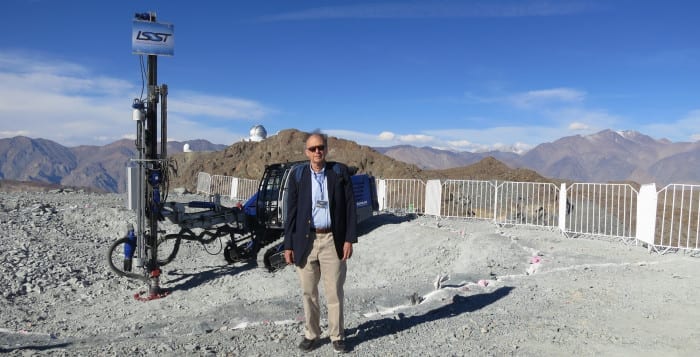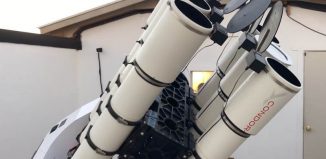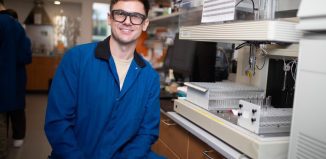BNL’s Morgan May gives telescope passing grades

Look! Up in the sky! It’s a bird, it’s a plane, it’s … billions of galaxies. Impossible to see with the naked eye, only vaguely visible through good telescopes, these galaxies will come to life in a way never seen before when the Large Synoptic Survey Telescope starts providing images from its mountaintop home in Chile in 2020.
Before this technological wonder is completed, people like Morgan May, a physicist at Brookhaven National Laboratory, are testing to make sure this ambitious project provides clear and accurate information.
Recently, May and his colleagues at BNL conducted two tests of the telescope.
The LSST will have 200 individual silicon sensors that are the film in the 3.2 gigapixel digital camera. The process of making the sensors is imperfect, with the sensors starting out as molten mass.
Impurities or variation in the temperature can cause imperfections that look like tree rings around a central circle, which create electric fields that can cause a distortion in the image.
“Because we are trying to measure things at a much higher level of precision, the tree rings were a source of great concern,” said May, who receives funding from the Department of Energy’s Office of Science-Cosmic Frontier Research.
They found that these radial imperfections were much smaller than in previous detectors, which was already a benefit to the project. Looking at the likely actual measurements using these sensors, May and his colleagues found that these tree rings had a small effect on the data, which was a pleasant surprise, but one that took some time to prove.
In another test, May, working with Columbia University graduate student Andrea Petri, examined whether differences in the sizes of the three billion pixels in the camera might also cause problems interpreting the information.
May and Yuki Okura, a postdoctoral fellow from Japan’s RIKEN laboratory who is stationed at the RIKEN-BNL Research Center, measured how much light each pixel picked up in the detector. While the variation was small, they weren’t sure whether it was small enough to keep from causing problems with the data.
The team simulated a night sky. Once they gathered the information they would have collected from these slight pixel differences, they compared their simulated image to their original.
Fortunately for the scientists, this effect also proved manageable and won’t create confusion.
May and Okura’s work “did have a good outcome,” said Sam Aronson, director of the RIKEN BNL Research Center. “They showed that the sensor imperfections measured on the LSST sensors will not affect LSST’s science objectives.”
While May is relieved the telescope passed these two tests, he continues to search for other potential problems with this revolutionary telescope.
“I am confident the LSST is going to be successful in its goals, but we have to work very hard to follow every possible issue and resolve it,” he said.
As a part of the LSST Dark Energy Science Collaboration, May said his primary research goal is to answer the question, “What is dark energy?” May said he will be studying subtle features of enormous amounts of information that will become available. May will be researching a force that causes the universe to expand faster and faster, rather than contract.
Until the 1930s, everyone thought the universe was contracting. Edwin Hubble, for whom the Hubble Space Telescope is named, was the first to observe this expansion. It is as if a ball thrown in the air slows down as expected and then accelerates away from Earth, May said. One well-regarded hypothesis is that the universe is filled with something called dark energy that causes a gravitational force that repels rather than attracts.
Once the telescope goes online, the information will become widely available.
“We’re going to make our data public to the everyone in the United States,” said May. It will be possible for “children in high school or even elementary school to have their own galaxy or supernova.”
Born in Brooklyn, May lives on Long Island with his wife Dana Vermilye. The couple have a 23-year old son, Michael, who is in medical school and a daughter, Julia, who is a high school sophomore.
May sees cosmology and astrophysics as a new frontier in science. “It’s an area where great discoveries are being made,” he said. “If you are interested in science as an observer or a career, I would say [it’s] really in the forefront.”






